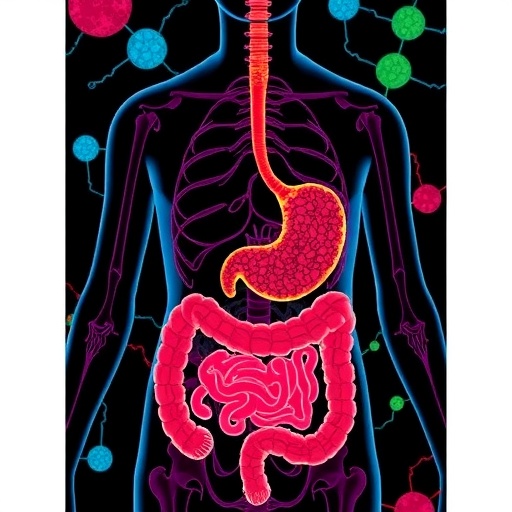The human gut microbiome, a complex and dynamic community of microorganisms residing within our digestive tract, is increasingly recognized as a pivotal player in human health and disease. Among its multifaceted roles, one of the most profound is its capacity to engage in chemical crosstalk with the host. This communication largely hinges upon small molecular byproducts generated when gut bacteria ferment dietary components that escape digestion in the upper gastrointestinal tract. These key metabolites—short-chain fatty acids such as acetate, propionate, and butyrate—are more than mere waste. They serve as bioactive messengers influencing immune modulation, maintaining intestinal epithelial integrity, and even modulating neurobehavioral processes. Despite the importance of these biochemical signals, precisely quantifying the daily molecular flux from gut fermentation to host tissues has remained an unresolved challenge—until now.
In a groundbreaking study published in the prestigious journal Cell, an interdisciplinary collaboration between ETH Zurich and Stanford University has, for the first time, provided an exact quantification of these microbial fermentation products delivered daily to the human body. This endeavor involved leveraging extensive data encompassing individual dietary intake and stool output volumes, integrating physiological measurements with advanced computational modeling. The team’s innovative approach allowed them to estimate the turnover of the gut microbial population alongside the stoichiometric demands for producing acetate, propionate, and butyrate at magnitudes sufficient to sustain bacterial biomass renewal.
From a methodological perspective, this study represents a novel synthesis between empirical data gathering and theoretical modeling. By correlating nutrient intake profiles with fecal biomass and microbial replication rates, the researchers created a model representing the kinetic production and absorption of fermentation metabolites. This dual-pronged strategy enabled them to map with unprecedented clarity how gut microbial communities sustain themselves through continuous fermentation and how this in turn translates into a quantifiable molecular handshake with the host. Markus Arnoldini, the study’s lead author, emphasizes that understanding this intimate material exchange is crucial not only for basic microbial ecology but also for grasping the mechanisms whereby gut microbiota shape systemic health.
.adsslot_h0ijMGxuO8{width:728px !important;height:90px !important;}
@media(max-width:1199px){ .adsslot_h0ijMGxuO8{width:468px !important;height:60px !important;}
}
@media(max-width:767px){ .adsslot_h0ijMGxuO8{width:320px !important;height:50px !important;}
}
ADVERTISEMENT
Digging deeper into the findings, the researchers have unveiled that while the specific composition of gut microbiota can shift—altering the relative proportions of fermentation products—the overall concentration of these molecules reaching the host remains relatively stable. This suggests a remarkable functional redundancy in the gut ecosystem, where fluctuations in microbial taxa do not substantially perturb the total metabolic output. Contrarily, variations in human diet emerge as the dominant factor modulating the absolute amounts of these microbial metabolites. This highlights dietary fiber and other fermentable substrates as critical levers in manipulating the biochemical dialogue between symbiotic bacteria and human physiology.
Remarkably, the fraction of a human’s daily energy intake derived from these microbial fermentation products varies widely depending on dietary habits. In typical modern Western diets, characterized by relatively low fiber consumption, these metabolites contribute only about 2 to 5 percent of the individual’s total energy expenditure. However, when examining traditional, high-fiber diets such as those observed in the Hadza hunter-gatherer population of Tanzania, this contribution can rise dramatically to encompass as much as 10 percent of daily caloric needs. This potent differential underscores how ancestral dietary patterns, rich in diverse plant polysaccharides, may have leveraged gut microbiota metabolism as a substantive energy source.
The findings from this study extend far beyond mere quantification; they offer a foundational framework for future exploration into how microbial metabolites influence disease states. The precise measurement of molecular exchange between gut bacteria and the host provides an indispensable tool to examine pathologies in which this equilibrium is disrupted. Chronic inflammatory conditions such as inflammatory bowel disease (IBD), colorectal cancer, and metabolic syndromes may be profoundly affected by alterations in fermentation product profiles. By applying these measurement techniques, researchers can potentially identify molecular signatures indicative of dysbiosis or microbial dysfunction, offering new avenues for diagnosis and therapy.
Another dimension illuminated by the study is the regulatory potential of these fermentation metabolites on the host immune system. Butyrate, for instance, is well-documented to enhance barrier function by promoting the regeneration of intestinal epithelial cells and modulating anti-inflammatory responses. Acetate and propionate also engage signaling pathways that influence immune cell differentiation and cytokine production. Quantitative insights into how diet-driven shifts in metabolite levels translate to immune modulation may open new therapeutic strategies aimed at harnessing microbial metabolites to restore immune homeostasis.
The study’s integrative approach, combining stool analyses, dietary records, and bacterial growth measurements, represents an exemplar of how systems biology can unravel the complex interactions within the gut microbiome-host nexus. This holistic analytical framework may be adapted to investigate temporal dynamics of metabolite production, circadian fluctuations, and inter-individual variability. Importantly, understanding the quantitative fluxes of microbial metabolites sets the stage for personalized nutrition strategies that optimize beneficial microbial output tailored to the individual’s metabolic health profile.
Equally compelling is the realization that modifying dietary inputs can exert a more pronounced impact on microbial metabolite concentrations than shifting the microbiome’s composition per se. This finding challenges some existing paradigms that focus predominantly on microbiome taxonomic shifts. Instead, it emphasizes the substrate availability and fermentative capacity of the microbiome as more critical determinants of the host’s molecular milieu. Harnessing this knowledge could revolutionize nutritional interventions, targeting fermentable dietary components to maximize therapeutic microbial metabolite levels.
The implications of this study reverberate across multiple domains, from clinical gastroenterology to neuropsychiatry. Emerging evidence suggests that microbial fermentation products can influence the gut-brain axis, modulating neurotransmitter synthesis and neuronal signaling pathways. Thus, precise quantification of these molecules lays an empirical foundation for linking gut microbial metabolism with behavioral and psychological outcomes. Furthermore, the approach pioneered in this research can be extended to probe how antibiotic use, probiotics, or prebiotics modulate the fermentative output of gut microbes and their systemic effects.
In summary, this landmark investigation by researchers at ETH Zurich and Stanford University pragmatically addresses a long-standing knowledge gap by delivering a detailed and precise quantification of microbial fermentation product fluxes in the human gut. By marrying comprehensive dietary data with microbial physiology and stool biophysics, the study elucidates how microbial communities sustain themselves metabolically and simultaneously furnish their host with important bioactive molecules. This quantitative lens on the gut microbiota-host material exchange deepens our understanding of nutritional ecology, offers mechanistic insights into health and disease, and opens avenues for targeted dietary and microbial therapeutics.
Looking forward, the methodologies developed herein hold transformative potential to deepen our mechanistic understanding of gut microbiome functions across diverse populations and disease contexts. As the scientific community continues unraveling the molecular underpinnings of host-microbe symbiosis, such precision measurements will be indispensable for translating basic microbiome science into actionable clinical and nutritional paradigms. The synergy between diet, microbial metabolism, and host physiology elucidated by this research heralds a new era of integrative biomedicine and personalized nutrition.
Subject of Research: People
Article Title: Quantifying the varying harvest of fermentation products from the human gut microbiota
News Publication Date: 30-Jul-2025
Web References: 10.1016/j.cell.2025.07.005
References: Cell, 2025
Keywords: Gut microbiome, microbial fermentation, short-chain fatty acids, acetate, propionate, butyrate, human gut metabolism, dietary influence, microbial ecology, host-microbe interaction, energy metabolism, immune modulation
Tags: advancements in microbiome researchchemical crosstalk in the gutdietary components and gut bacteriaETH Zurich and Stanford University studygut microbiome healthimmune system modulationinterdisciplinary research in microbiomeintestinal health and integritymicrobial fermentation productsneurobehavioral processes and gutquantifying gut microbial metabolitesshort-chain fatty acids





